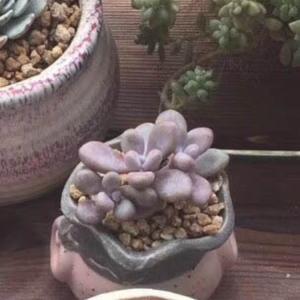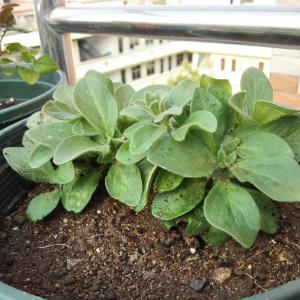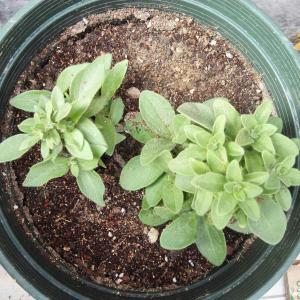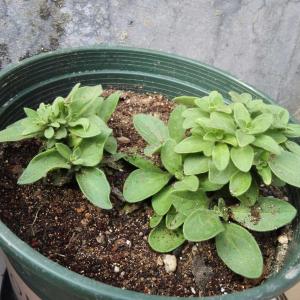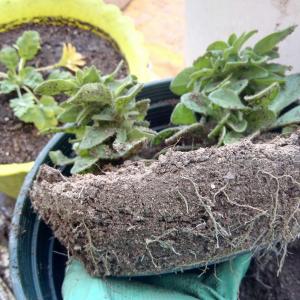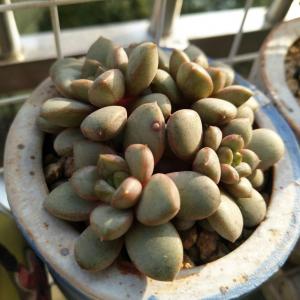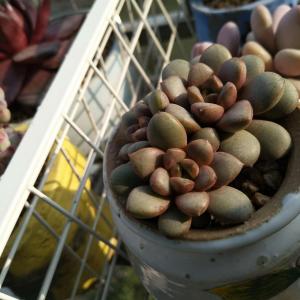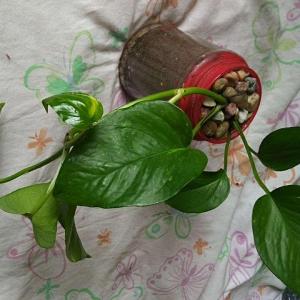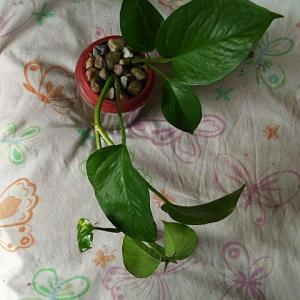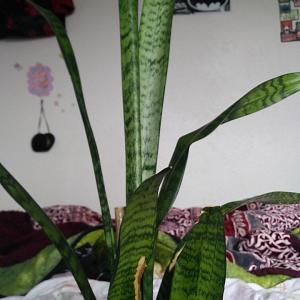文章
家里的二哈爱吃花
2018年02月21日


病害之:黑斑病
发生这种病害,主要会表现在叶子上,发病的时间大约是3月至5月期间。发病时叶子表面会出现深色的斑点,这些小斑点会随着时间慢慢扩大,若不及时救治,整片叶子都会被这些斑点覆盖至掉落。
防治方法:发生病害时,可以用药用喷洒,阻碍它扩大。在临近病害发生时,可以先用药物进行预防。

病害之:炭疽病
此病害主要表现在叶子与枝茎上。发生病害时,叶子表面会出现黑色的斑点,发病时间大约是1月至5月期间。
防治方法:用药物进行喷洒。
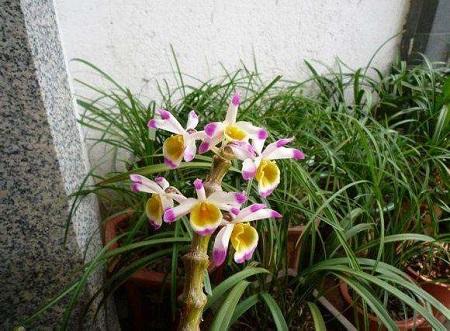
病害之:煤污病
病如期名,发生此病害时,整株植物的叶子都会被一层类似煤烟覆盖,从而使阳光无法与叶子直接接触,让植物无法在进行光合作用,也就导致植物无法正常生长。发病的主要时间是3月至5月期间。
防治方法:用药物进行喷洒。

虫害之:菲盾蚧
此虫害是以吸取植物的汁液生存的,若不及时防治,时间过长,整株植物都会因为水分的流失而死亡,有时还会造成其它病害。此虫害发生的时间是5月份开始。
防治方法:若发现较早,可以把虫害侵蚀过的枝叶全部剪除,较严重时就要用药物进行喷杀。
虫害之:蜗牛
引病害友友们应该常见了吧,很多蔬菜中都有它的身影。它主要是啃食植物来生存,而且没有固定的发生时间。最主要的是它的危害程度较大。
防治方法:可以下诱饵进行诱杀,同时还要用药物进行喷洒。日常养护时,一定要注意植株的干净整洁。
0
0
文章
Miss Chen
2018年02月20日

Description: This perennial plant is about 1½–3' tall and unbranched, except for the flowering stalks near the apex. Missouri Goldenrod produces both fertile (flowering) and sterile (non-flowering) shoots. The central stem is light green to dark red, terete (round in circumference), and glabrous; the lower portion of this stem may become slightly woody with age. Along the entire length of this stem, there are alternate leaves that become smaller as they ascend. These leaves are up to 5" long and ¾" across; they are more or less elliptic in shape and serrated along their middle to outer margins. Each leaf usually has 3 prominent veins (a central vein & 2 lateral veins); the lateral veins are parallel with the central vein along much of its length. However, on many upper leaves only the central vein is prominent. The tips of the leaves are acute, while their bases taper gradually into petioles. Most of these petioles are 3 mm. or less in length, although the lowest leaves have longer petioles that are partially winged. From the axils of the middle to upper leaves, short tufts of small secondary leaves may develop. The upper leaf surface is medium green and glabrous, while the lower leaf surface is light green and glabrous.
Panicle of Flowerheads
A panicle of flowerheads up to 6" long and 4" across terminates the central stem of each fertile shoot. This panicle is pyramidal, obpyramidal, or rhomboid in outline; its branches are widely spreading to ascending and straight to somewhat recurved. These branches divide into short secondary branches and peduncles; the latter terminate in small flowerheads. The branches and peduncles are light green to nearly white and either glabrous or pubescent. Intermingled among these branches, there are small leafy bracts up to 1½" long and ¼" (6 mm.) across. Each flowerhead is about 3 mm. across and 5 mm. long; it consists of several disk florets that are surrounded by 6-12 ray florets. The tiny corollas of these florets are yellow to golden yellow; they are tubular in shape with 5 spreading to ascending lobes along their upper rims. The petaloid rays of the flowerheads are bright yellow, oblong in shape, and widely spreading. Surrounding the base of each flowerhead, there are phyllaries (floral bracts) in several overlapping series; they are about 2 mm. long, light green to light yellow, oblong in shape, glabrous, and appressed together. The blooming period usually occurs from mid-summer to late summer, lasting about 3 weeks for a colony of plants. Afterwards, the florets are replaced by achenes with small tufts of white hair at their apices. These achenes are about 2 mm. long and bullet-shaped; they are distributed by the wind.

The root system is mostly fibrous and rhizomatous; an older plant may produce a small caudex. Missouri Goldenrod reproduces by clonal offsets from the rhizomes and by reseeding itself. It often forms colonies that contain both fertile and infertile shoots.
Cultivation: The preference is full sun to partial sun, mesic to dry conditions, and soil that contains loam, clay-loam, or rocky material. Like many goldenrod species, Missouri Goldenrod is easy to grow. While this goldenrod will spread in cultivation from its rhizomes, it is shorter and less aggressive than the common Canada Goldenrod (Solidago canadensis).
Range & Habitat: Missouri Goldenrod occurs occasionally in most areas of Illinois (see Distribution Map), where it is native. Habitats include black soil prairies, clay prairies, dolomite prairies, hill prairies, limestone glades, prairie remnants along railroads, and thickets in upland areas. In Illinois, this goldenrod has high fidelity to prairies that can vary in their quality. Because of the destruction of prairie habitat, it is less common within the state than in the past.

Faunal Associations: Small bees, wasps, flies, and beetles visit the flowers for nectar and/or pollen, including Chauliognathus pennsylvanica (Goldenrod Soldier Beetle) and Epicauta pensylvanica (Black Blister Beetle). Many grasshopper species feed on the foliage of Missouri Goldenrod (see Grasshopper Table), as do the leaf beetles Microrhopala vittata, Trirhabda borealis, Trirhabda canadensis, Trirhabda convergens, and Trirhabda virgata. The caterpillars of many moth species feed on this and other goldenrods (see Moth Table). Other insect feeders include stink bugs, plant bugs, the larvae of small flies (Tephritidae), and thrips. The Greater Prairie Chicken eats the foliage, while the Eastern Goldfinch and various sparrows eat the seeds to a minor extent. Although goldenrods are not preferred as a food source, the White-Tailed Deer, Cottontail Rabbit, and livestock eat the foliage occasionally. Prairie Voles and Meadow Voles eat both the seeds and foliage.
Photographic Location: The Buffalo Trace Prairie at Lake-of-the-Woods, Champaign County, Illinois, and a wildflower garden of the webmaster in Urbana, Illinois.

Comments: Missouri Goldenrod (Solidago missouriensis) is rather variable across its range, making it difficult to distinguish from other goldenrods (Solidago spp.). More specifically, the shape of the inflorescence of this goldenrod is rather variable, the leaves vary in regards to how much smaller they become as they ascend the stems, and the flowering branches can be glabrous or pubescent. In particular, Missouri Goldenrod can be difficult to distinguish from Early Goldenrod (Solidago juncea). Both of these goldenrods bloom earlier than most goldenrods and they are found in similar habitats. While Early Goldenrod begins to bloom about 2 weeks earlier than Missouri Goldenrod, there blooming periods overlap to some extent. Usually the inflorescence of Early Goldenrod has flowering branches that are more recurved and widely spreading than those of Missouri Goldenrod, and it lacks 3-veined leaves. Another goldenrod that Missouri Goldenrod has some resemblance to, Giant Goldenrod (Solidago gigantea), differs by its greater height, later blooming period, and preference for damp habitats. The leaves of Giant Goldenrod vary little in size as they ascend the stems, while the leaves of Missouri Goldenrod are more likely to become smaller. Another rather variable species, Showy Goldenrod (Solidago speciosa), also differs by its greater height and later blooming period. In addition, it lacks the 3-veined leaves of Missouri Goldenrod, and the flowering branches of its panicles curve inward, rather than outward.
Panicle of Flowerheads
A panicle of flowerheads up to 6" long and 4" across terminates the central stem of each fertile shoot. This panicle is pyramidal, obpyramidal, or rhomboid in outline; its branches are widely spreading to ascending and straight to somewhat recurved. These branches divide into short secondary branches and peduncles; the latter terminate in small flowerheads. The branches and peduncles are light green to nearly white and either glabrous or pubescent. Intermingled among these branches, there are small leafy bracts up to 1½" long and ¼" (6 mm.) across. Each flowerhead is about 3 mm. across and 5 mm. long; it consists of several disk florets that are surrounded by 6-12 ray florets. The tiny corollas of these florets are yellow to golden yellow; they are tubular in shape with 5 spreading to ascending lobes along their upper rims. The petaloid rays of the flowerheads are bright yellow, oblong in shape, and widely spreading. Surrounding the base of each flowerhead, there are phyllaries (floral bracts) in several overlapping series; they are about 2 mm. long, light green to light yellow, oblong in shape, glabrous, and appressed together. The blooming period usually occurs from mid-summer to late summer, lasting about 3 weeks for a colony of plants. Afterwards, the florets are replaced by achenes with small tufts of white hair at their apices. These achenes are about 2 mm. long and bullet-shaped; they are distributed by the wind.

The root system is mostly fibrous and rhizomatous; an older plant may produce a small caudex. Missouri Goldenrod reproduces by clonal offsets from the rhizomes and by reseeding itself. It often forms colonies that contain both fertile and infertile shoots.
Cultivation: The preference is full sun to partial sun, mesic to dry conditions, and soil that contains loam, clay-loam, or rocky material. Like many goldenrod species, Missouri Goldenrod is easy to grow. While this goldenrod will spread in cultivation from its rhizomes, it is shorter and less aggressive than the common Canada Goldenrod (Solidago canadensis).
Range & Habitat: Missouri Goldenrod occurs occasionally in most areas of Illinois (see Distribution Map), where it is native. Habitats include black soil prairies, clay prairies, dolomite prairies, hill prairies, limestone glades, prairie remnants along railroads, and thickets in upland areas. In Illinois, this goldenrod has high fidelity to prairies that can vary in their quality. Because of the destruction of prairie habitat, it is less common within the state than in the past.

Faunal Associations: Small bees, wasps, flies, and beetles visit the flowers for nectar and/or pollen, including Chauliognathus pennsylvanica (Goldenrod Soldier Beetle) and Epicauta pensylvanica (Black Blister Beetle). Many grasshopper species feed on the foliage of Missouri Goldenrod (see Grasshopper Table), as do the leaf beetles Microrhopala vittata, Trirhabda borealis, Trirhabda canadensis, Trirhabda convergens, and Trirhabda virgata. The caterpillars of many moth species feed on this and other goldenrods (see Moth Table). Other insect feeders include stink bugs, plant bugs, the larvae of small flies (Tephritidae), and thrips. The Greater Prairie Chicken eats the foliage, while the Eastern Goldfinch and various sparrows eat the seeds to a minor extent. Although goldenrods are not preferred as a food source, the White-Tailed Deer, Cottontail Rabbit, and livestock eat the foliage occasionally. Prairie Voles and Meadow Voles eat both the seeds and foliage.
Photographic Location: The Buffalo Trace Prairie at Lake-of-the-Woods, Champaign County, Illinois, and a wildflower garden of the webmaster in Urbana, Illinois.

Comments: Missouri Goldenrod (Solidago missouriensis) is rather variable across its range, making it difficult to distinguish from other goldenrods (Solidago spp.). More specifically, the shape of the inflorescence of this goldenrod is rather variable, the leaves vary in regards to how much smaller they become as they ascend the stems, and the flowering branches can be glabrous or pubescent. In particular, Missouri Goldenrod can be difficult to distinguish from Early Goldenrod (Solidago juncea). Both of these goldenrods bloom earlier than most goldenrods and they are found in similar habitats. While Early Goldenrod begins to bloom about 2 weeks earlier than Missouri Goldenrod, there blooming periods overlap to some extent. Usually the inflorescence of Early Goldenrod has flowering branches that are more recurved and widely spreading than those of Missouri Goldenrod, and it lacks 3-veined leaves. Another goldenrod that Missouri Goldenrod has some resemblance to, Giant Goldenrod (Solidago gigantea), differs by its greater height, later blooming period, and preference for damp habitats. The leaves of Giant Goldenrod vary little in size as they ascend the stems, while the leaves of Missouri Goldenrod are more likely to become smaller. Another rather variable species, Showy Goldenrod (Solidago speciosa), also differs by its greater height and later blooming period. In addition, it lacks the 3-veined leaves of Missouri Goldenrod, and the flowering branches of its panicles curve inward, rather than outward.
0
0
文章
Miss Chen
2018年02月20日

Description: This herbaceous perennial plant is unbranched and up to 3' tall. The central stem is slightly ridged, hairless, and green or reddish. The alternate leaves are up to 8" long and 1½" across, becoming much smaller as they ascend up the stem. They are lanceolate, oblanceolate, or narrowly ovate, while their margins are smooth or slightly serrated. Sometimes there are tiny hairs along the margins, otherwise the leaves are hairless. The leaves are sessile or taper gradually to a petiole-like base. Above their axils along the central stem are small wing-like leaflets. The inflorescence occurs at the apex of the plant, and consists of a panicle of flowering stems that often arch upward and outward like a fireworks display. There are numerous yellow composite flowers, each about ¼" across. From 4 to 12 ray florets can be observed around the disk florets, often unevenly spaced and not open at the same time. The flowers may have a mild fragrance. The blooming period occurs during mid- to late summer, and lasts about 1 to 1½ months. Later, the achenes develop with small tufts of hair, which are dispersed by wind. The root system consists of a short caudex (on old plants), which may produce rhizomes and vegetative offshoots.
Cultivation: The preference is full to partial sun, and mesic to slightly dry conditions. Moist conditions are tolerated, if the soil is reasonably well-drained. This plant is not fussy about soil texture, which can contain loam, clay, sand, or gravel. Foliar disease is not normally a problem until after the blooming period, when mildew and other diseases may appear.
Range & Habitat: The native Early Goldenrod is widely distributed throughout Illinois, occurring in most counties (see Distribution Map). It is occasional to locally common. Early Goldenrod occurs in mesic to slightly dry black soil prairies, sand prairies, gravel prairies, oak savannas, thickets, open areas of rocky upland woods, sunny waste areas, and abandoned fields. It is the earliest goldenrod to bloom in these habitats in Illinois.

Faunal Associations: Like other goldenrods, this plant attracts many kinds of insects to the flowers, including long-tongued and short-tongued bees, wasps, flies, butterflies, moths, and beetles, including Chauliognathus pennsylvanicus (Goldenrod Soldier Beetle). The caterpillars of many moths feed on the foliage and other parts of this goldenrod (see Moth Table), while the adults of Cirrhophanus triangulifer (Goldenrod Stowaway Moth) like to hide in the flowers. Other insects feed on this and other goldenrods, including various lace bugs, leafhoppers, seed beetles, leaf beetles, and Lygus lineolaris (Tarnished Plant Bug). The Greater Prairie Chicken may feed on the foliage, while the Eastern Goldfinch, Tree Sparrow, and Swamp Sparrow eat the seeds to a limited extent. Mammalian herbivores may feed on the foliage if little else is available, including the White-Tailed Deer, Groundhog, Cottontail Rabbit, and livestock.

Photographic Location: The photographs were taken at Loda Cemetery Prairie in Iroquois County, Illinois.
Comments: This is the earliest blooming goldenrod. It is an attractive, slender plant with a delicate appearance. Aside from its early bloom, Early Goldenrod can be distinguished from other goldenrods by the near or complete absence of hair on the stems and leaves (unlike Solidago nemoralis), the presence of winged leaflets above the leaf axils on the central stem (unlike Solidago canadensis), and an inflorescence that flares outward (rather than upward, like Solidago speciosa). No other goldenrod that occurs on prairies in Illinois has this combination of features.
Cultivation: The preference is full to partial sun, and mesic to slightly dry conditions. Moist conditions are tolerated, if the soil is reasonably well-drained. This plant is not fussy about soil texture, which can contain loam, clay, sand, or gravel. Foliar disease is not normally a problem until after the blooming period, when mildew and other diseases may appear.
Range & Habitat: The native Early Goldenrod is widely distributed throughout Illinois, occurring in most counties (see Distribution Map). It is occasional to locally common. Early Goldenrod occurs in mesic to slightly dry black soil prairies, sand prairies, gravel prairies, oak savannas, thickets, open areas of rocky upland woods, sunny waste areas, and abandoned fields. It is the earliest goldenrod to bloom in these habitats in Illinois.

Faunal Associations: Like other goldenrods, this plant attracts many kinds of insects to the flowers, including long-tongued and short-tongued bees, wasps, flies, butterflies, moths, and beetles, including Chauliognathus pennsylvanicus (Goldenrod Soldier Beetle). The caterpillars of many moths feed on the foliage and other parts of this goldenrod (see Moth Table), while the adults of Cirrhophanus triangulifer (Goldenrod Stowaway Moth) like to hide in the flowers. Other insects feed on this and other goldenrods, including various lace bugs, leafhoppers, seed beetles, leaf beetles, and Lygus lineolaris (Tarnished Plant Bug). The Greater Prairie Chicken may feed on the foliage, while the Eastern Goldfinch, Tree Sparrow, and Swamp Sparrow eat the seeds to a limited extent. Mammalian herbivores may feed on the foliage if little else is available, including the White-Tailed Deer, Groundhog, Cottontail Rabbit, and livestock.

Photographic Location: The photographs were taken at Loda Cemetery Prairie in Iroquois County, Illinois.
Comments: This is the earliest blooming goldenrod. It is an attractive, slender plant with a delicate appearance. Aside from its early bloom, Early Goldenrod can be distinguished from other goldenrods by the near or complete absence of hair on the stems and leaves (unlike Solidago nemoralis), the presence of winged leaflets above the leaf axils on the central stem (unlike Solidago canadensis), and an inflorescence that flares outward (rather than upward, like Solidago speciosa). No other goldenrod that occurs on prairies in Illinois has this combination of features.
0
0
文章
Miss Chen
2018年02月20日

Description: This herbaceous perennial plant is up to 3' tall, branching occasionally. The stems have scattered white or yellow spines. The alternate leaves are up to 6" long and 3" across, and have short petioles. They are broadly lanceolate or ovate, but rather angular along the margins, which are slightly ciliate. There are white hairs and scattered spines along the central vein on the underside of each leaf.
The upper stems terminate in small clusters of star-shaped flowers with hairy pedicels. These flowers are white or light violet, about ¾" across, and have 5 petals that are united at the base. Near the center, there are 5 elongated yellow anthers that are very prominent. There is no noticeable floral scent. The blooming period can occur from early summer to early fall, and typically lasts about 1½ months. Afterwards, round fruits develop that are a little more than ½" across and half-enclosed by a papery calyx. They become yellow when mature, but are not edible to humans. Each fruit contains numerous seeds that are glossy yellow and flattened. The root system has creeping underground rhizomes, which are responsible for the vegetative spread of this plant.

Cultivation: The preference is full sun and moist to dry conditions. Horse Nettle grows readily in loamy or sandy soil, and probably other soil types as well. It is a rather weedy plant that can become aggressive at disturbed sites.
Range & Habitat: The native Horse Nettle occurs in every county of Illinois and it is very common (see Distribution Map). Habitats include mesic to dry black soil prairies, clay prairies, sand prairies, openings and edges of woodlands, abandoned fields, areas along roadsides and railroads, yards and gardens, vacant lots, and other waste areas. This plant is most typically observed in disturbed areas, but it can be found occasionally even in high quality habitats.

Faunal Associations: Bumblebees visit the flowers to collect pollen, using 'buzz pollination,' which involves the rapid vibration of thoracic muscles. The caterpillars of the day-flying moth Synanthedon rileyana (Riley's Clearwing) feed on Horse Nettle. This moth is a wasp mimic. The mature yellow fruits are eaten, to a limited extent, by the Ring-Necked Pheasant, Bobwhite, Wild Turkey, Eastern Striped Skunk, and possibly small rodents, thereby promoting the distribution of the seeds and spread of this plant. They are apparently more immune to the reduced toxicity of the mature fruit than humans. Experimental studies have shown that the seeds can pass unharmed through the digestive tracts of livestock. Mammalian herbivores avoid eating the stems and foliage of this plant because of their scattered spines and toxicity; the latter is the result of solanum, an alkaloid compound that also occurs in other members of the Nightshade family.

Photographic Location: The photographs were taken at the webmaster's apartment complex in Urbana, Illinois, and a gravelly area along a railroad in Champaign, Illinois.
Comments: Horse Nettle is widely regarded as a weed with some justication, but it is also one of the native wildflowers of the prairie. The fruits are benefical to wildlife. Because of the intense competition among plants and their root systems, this plant is less aggressive in prairie habitats than in disturbed sites around developed areas.
The upper stems terminate in small clusters of star-shaped flowers with hairy pedicels. These flowers are white or light violet, about ¾" across, and have 5 petals that are united at the base. Near the center, there are 5 elongated yellow anthers that are very prominent. There is no noticeable floral scent. The blooming period can occur from early summer to early fall, and typically lasts about 1½ months. Afterwards, round fruits develop that are a little more than ½" across and half-enclosed by a papery calyx. They become yellow when mature, but are not edible to humans. Each fruit contains numerous seeds that are glossy yellow and flattened. The root system has creeping underground rhizomes, which are responsible for the vegetative spread of this plant.

Cultivation: The preference is full sun and moist to dry conditions. Horse Nettle grows readily in loamy or sandy soil, and probably other soil types as well. It is a rather weedy plant that can become aggressive at disturbed sites.
Range & Habitat: The native Horse Nettle occurs in every county of Illinois and it is very common (see Distribution Map). Habitats include mesic to dry black soil prairies, clay prairies, sand prairies, openings and edges of woodlands, abandoned fields, areas along roadsides and railroads, yards and gardens, vacant lots, and other waste areas. This plant is most typically observed in disturbed areas, but it can be found occasionally even in high quality habitats.

Faunal Associations: Bumblebees visit the flowers to collect pollen, using 'buzz pollination,' which involves the rapid vibration of thoracic muscles. The caterpillars of the day-flying moth Synanthedon rileyana (Riley's Clearwing) feed on Horse Nettle. This moth is a wasp mimic. The mature yellow fruits are eaten, to a limited extent, by the Ring-Necked Pheasant, Bobwhite, Wild Turkey, Eastern Striped Skunk, and possibly small rodents, thereby promoting the distribution of the seeds and spread of this plant. They are apparently more immune to the reduced toxicity of the mature fruit than humans. Experimental studies have shown that the seeds can pass unharmed through the digestive tracts of livestock. Mammalian herbivores avoid eating the stems and foliage of this plant because of their scattered spines and toxicity; the latter is the result of solanum, an alkaloid compound that also occurs in other members of the Nightshade family.

Photographic Location: The photographs were taken at the webmaster's apartment complex in Urbana, Illinois, and a gravelly area along a railroad in Champaign, Illinois.
Comments: Horse Nettle is widely regarded as a weed with some justication, but it is also one of the native wildflowers of the prairie. The fruits are benefical to wildlife. Because of the intense competition among plants and their root systems, this plant is less aggressive in prairie habitats than in disturbed sites around developed areas.
0
0
文章
Miss Chen
2018年02月20日

Description: This perennial plant is ½–1' tall, forming a a tuft of linear basal leaves with smooth margins. The basal leaves are 2-3 mm. across, flattened, pale green, and glabrous. One or more flowering stalks develop from among the basal leaves; these stalks are about the same length or somewhat taller than the leaves. The linear stalks are 1-2 mm. across, pale green, and glabrous; each stalk has a stiff raised ridge that runs along the flattened sides of its length. Each stalk produces a pair of sessile claw-like bracts (or spathe) near its apex, between which a single umbel of flowers occurs. The outer bract is ¾-1" long, while the inner bract is ½-¾" in length (sometimes the inner bract isn't distinct from the flowering stalk during the early stage of its development). Both bracts are some shade of pale green, pinkish purple, or brownish purple; they are linear-lanceolate in shape, slightly curved, and usually glabrous. The outer bract is somewhat swollen at its base. Each umbel has 3-6 flowers on slender pedicels that are about the same length as the bracts. The flower buds are hairy and nodding, while flowers in bloom are held more erect. Each flowers is up to ½" across, consisting of 6 tepals that are blue-violet, light blue, or white, and a yellow spike-like structure in its center that contains the reproductive organs. Near the center of the flower, the tepals are yellow. The tepals are oblong-elliptic in shape and they taper abruptly into short narrow tips. The blooming period occurs from late spring to early summer, lasting about 3 weeks. There is no noticeable floral scent. The flowers are replaced by 3-celled seed capsules. At maturity, these capsules are about 3 mm. long, ovoid-globoid in shape, and glabrous. Eventually, each capsule splits open into 3 sections to release the small dark seeds. The seeds are small enough to be dispersed a limited distance by gusts of wind. The root system is coarsely fibrous, and new plants can develop vegetatively from adjacent offsets.
Cultivation: The preference is full sun and mesic to dry conditions. The soil can contain significant amounts of loam, rocky material, or sand. This species of Blue-Eyed Grass is more drought-resistant than most of the others. Foliar disease is rarely a problem. While this plant can slowly spread by forming larger clumps, it is not aggressive.
Range & Habitat: Prairie Blue-Eyed Grass occurs primarily in western and northern Illinois, where it is fairly uncommon; in other parts of the state, this plant is rare or absent (see Distribution Map). Habitats include mesic to dry black soil prairies, sand prairies, hill prairies, savannas, limestone glades, sandy meadows in wooded areas, abandoned fields, and areas along railroads. This plant is usually found in high quality habitats.
Faunal Associations: The flowers are visited primarily by short-tongued bees, including Halictid bees and masked bees (Hylaeus spp.), where they seek nectar and pollen. Syrphid flies also visit the flowers, where they feed primarily on stray pollen. The Wild Turkey and Greater Prairie Chicken eat the seed capsules and/or foliage to a limited extent.

Photographic Location: The photographs were taken at Prospect Cemetery Prairie in Ford County, Illinois.
Comments: It can be difficult to distinguish the different species of Blue-Eyed Grass. The white form of Prairie Blue-Eyed Grass (as illustrated in the photographs) is quite similar in appearance to Sisyrinchium albidum (White Blue-Eyed Grass). Like most Sisyrinchium spp., Prairie Blue-Eyed Grass produces a single umbel of flowers between a pair of bracts on each flowering stalk, while White Blue-Eyed Grass produces 2 pairs of bracts with 2 umbels of flowers on each flowering stalk. White Blue-Eyed Grass also has slightly larger seed capsules and slightly wider leaves and flowering stalks. When Prairie Blue-Eyed Grass has blue-violet flowers, it can be confused with other Sisyrinchium spp. Generally, Prairie Blue-Eyed Grass has leaves and flowering stalks that are no wider than those of other species, and it never produces secondary flowering stalks from the primary flowering stalks that originate from among the basal leaves. The common name for this genus, Blue-Eyed Grass, is something of a misnomer because the flowers, whether white or blue-violet, have yellow centers.
Cultivation: The preference is full sun and mesic to dry conditions. The soil can contain significant amounts of loam, rocky material, or sand. This species of Blue-Eyed Grass is more drought-resistant than most of the others. Foliar disease is rarely a problem. While this plant can slowly spread by forming larger clumps, it is not aggressive.
Range & Habitat: Prairie Blue-Eyed Grass occurs primarily in western and northern Illinois, where it is fairly uncommon; in other parts of the state, this plant is rare or absent (see Distribution Map). Habitats include mesic to dry black soil prairies, sand prairies, hill prairies, savannas, limestone glades, sandy meadows in wooded areas, abandoned fields, and areas along railroads. This plant is usually found in high quality habitats.
Faunal Associations: The flowers are visited primarily by short-tongued bees, including Halictid bees and masked bees (Hylaeus spp.), where they seek nectar and pollen. Syrphid flies also visit the flowers, where they feed primarily on stray pollen. The Wild Turkey and Greater Prairie Chicken eat the seed capsules and/or foliage to a limited extent.

Photographic Location: The photographs were taken at Prospect Cemetery Prairie in Ford County, Illinois.
Comments: It can be difficult to distinguish the different species of Blue-Eyed Grass. The white form of Prairie Blue-Eyed Grass (as illustrated in the photographs) is quite similar in appearance to Sisyrinchium albidum (White Blue-Eyed Grass). Like most Sisyrinchium spp., Prairie Blue-Eyed Grass produces a single umbel of flowers between a pair of bracts on each flowering stalk, while White Blue-Eyed Grass produces 2 pairs of bracts with 2 umbels of flowers on each flowering stalk. White Blue-Eyed Grass also has slightly larger seed capsules and slightly wider leaves and flowering stalks. When Prairie Blue-Eyed Grass has blue-violet flowers, it can be confused with other Sisyrinchium spp. Generally, Prairie Blue-Eyed Grass has leaves and flowering stalks that are no wider than those of other species, and it never produces secondary flowering stalks from the primary flowering stalks that originate from among the basal leaves. The common name for this genus, Blue-Eyed Grass, is something of a misnomer because the flowers, whether white or blue-violet, have yellow centers.
0
0
文章
Miss Chen
2018年02月12日

Description: This herbaceous perennial plant is 3-5' tall and unbranched, except near the inflorescence. The stout central stem is usually covered with stiff short hairs, but sometimes becomes glabrous with age. It is usually light green, but sometimes turns red in the presence of bright sunlight. The opposite leaves are up to 5" long and 2½" wide. They are broadly lanceolate to ovate, and have stiff small hairs on both the upper and lower sides, providing a sandpapery texture. The margins of these leaves are usually smooth, or they may have tiny teeth. As they ascend the stem, the opposite leaves rotate their direction by 90°.
A panicle of composite yellow flowers appear at the top of the plant, resembling small sunflowers. Each flower is about 2–3" across, consisting of numerous disk florets surrounded by 12-25 ray florets. Only the ray florets are fertile. There is no noticeable floral scent. Often, there are side stems that bear smaller panicles of flowers. The blooming period occurs from mid-summer to fall, and lasts about 1-2 months. The seeds are large, flat, and lightweight – they can be carried several feet by the wind. The root system consists of a taproot and short rhizomes, which enable this plant to form clumps. Several varieties of this plant have been reported by various authorities, some of which may be natural hybrids with other Silphium spp.
Cultivation: The preference is full sun and mesic to dry conditions. The soil can contain loam, clay-loam, or some gravel. Rosinweed is rarely bothered by disease and is easy to grow. It matures more quickly than many other members of the genus, such as Silphium terebinthinaceum (Prairie Dock) and Silphium laciniatum (Compass Plant). Another nice feature of this plant is that it rarely flops over in the flower garden, if the location isn't on a steep slope.

Range & Habitat: The native Rosinweed occurs throughout most of Illinois, except for a few southern and western counties (see Distribution Map). It is a fairly common plant. Habitats include mesic to dry black soil prairies, gravel prairies, clay prairies, hill prairies, openings in rocky upland forests, limestone glades, and areas along railroads, particularly where prairie remnants occur. This plant can survive significant degradation, and recovers readily from occasional wildfires. It competes well against most prairie grasses and forbs in mesic to dry areas.
Faunal Associations: The pollen and nectar of the flowers attract long-tongued bees primarily, including honeybees, bumblebees, Little Carpenter bees, Epeoline Cuckoo bees, Miner bees, and large Leaf-Cutting bees. Insects rarely attack this plant, although the Silphium Beetle (Rhynchites sp.) may feed on the flowers and seeds, and the caterpillars of the rare Tabenna silphiella (Silphium Moth) eat the epidermis of the leaves. The larvae of a Gall Wasp (Antistrophus sp.) may feed within the stems, forming galls that are invisible from the outside. They attract the hyperparasitic wasp Eurytoma lutea, whose larvae feed on the larvae of the Gall Wasp. Some butterflies occasionally visit the flowers, including Sulfurs and Painted Ladies. Other visitors include short-tongued bees and various flies. The seeds are eaten occasionally by Goldfinches. Small herbivores, such as rabbits, are less likely to eat this plant because of its height and the coarseness of its leaves. However, some large herbivores, such as cattle, readily consume the foliage, stems, and flowers.
Photographic Location: The photographs were taken at Meadowbrook Park in Urbana, Illinois.
Comments: Like other Silphium spp., Rosinweed has a fragrant resin while in flower, which was chewed as gum by Amerindian children. It is less dramatic in appearance than some of its gigantic cousins, but matures more quickly and tolerates drought as well or better. Rosinweed resembles many Helianthus spp. (Sunflowers), but its disk florets are sterile and ray florets are fertile. The Sunflowers, on the other hand, have fertile disk florets and sterile ray florets. Rosinweed tends to produce flowers earlier than the Sunflowers, but sometimes their blooming periods overlap. While this plant can form sizable clumps, it doesn't spread as aggressively by means of underground rhizomes as many Sunflower species, nor is it known to be allelopathic.
A panicle of composite yellow flowers appear at the top of the plant, resembling small sunflowers. Each flower is about 2–3" across, consisting of numerous disk florets surrounded by 12-25 ray florets. Only the ray florets are fertile. There is no noticeable floral scent. Often, there are side stems that bear smaller panicles of flowers. The blooming period occurs from mid-summer to fall, and lasts about 1-2 months. The seeds are large, flat, and lightweight – they can be carried several feet by the wind. The root system consists of a taproot and short rhizomes, which enable this plant to form clumps. Several varieties of this plant have been reported by various authorities, some of which may be natural hybrids with other Silphium spp.
Cultivation: The preference is full sun and mesic to dry conditions. The soil can contain loam, clay-loam, or some gravel. Rosinweed is rarely bothered by disease and is easy to grow. It matures more quickly than many other members of the genus, such as Silphium terebinthinaceum (Prairie Dock) and Silphium laciniatum (Compass Plant). Another nice feature of this plant is that it rarely flops over in the flower garden, if the location isn't on a steep slope.

Range & Habitat: The native Rosinweed occurs throughout most of Illinois, except for a few southern and western counties (see Distribution Map). It is a fairly common plant. Habitats include mesic to dry black soil prairies, gravel prairies, clay prairies, hill prairies, openings in rocky upland forests, limestone glades, and areas along railroads, particularly where prairie remnants occur. This plant can survive significant degradation, and recovers readily from occasional wildfires. It competes well against most prairie grasses and forbs in mesic to dry areas.
Faunal Associations: The pollen and nectar of the flowers attract long-tongued bees primarily, including honeybees, bumblebees, Little Carpenter bees, Epeoline Cuckoo bees, Miner bees, and large Leaf-Cutting bees. Insects rarely attack this plant, although the Silphium Beetle (Rhynchites sp.) may feed on the flowers and seeds, and the caterpillars of the rare Tabenna silphiella (Silphium Moth) eat the epidermis of the leaves. The larvae of a Gall Wasp (Antistrophus sp.) may feed within the stems, forming galls that are invisible from the outside. They attract the hyperparasitic wasp Eurytoma lutea, whose larvae feed on the larvae of the Gall Wasp. Some butterflies occasionally visit the flowers, including Sulfurs and Painted Ladies. Other visitors include short-tongued bees and various flies. The seeds are eaten occasionally by Goldfinches. Small herbivores, such as rabbits, are less likely to eat this plant because of its height and the coarseness of its leaves. However, some large herbivores, such as cattle, readily consume the foliage, stems, and flowers.
Photographic Location: The photographs were taken at Meadowbrook Park in Urbana, Illinois.
Comments: Like other Silphium spp., Rosinweed has a fragrant resin while in flower, which was chewed as gum by Amerindian children. It is less dramatic in appearance than some of its gigantic cousins, but matures more quickly and tolerates drought as well or better. Rosinweed resembles many Helianthus spp. (Sunflowers), but its disk florets are sterile and ray florets are fertile. The Sunflowers, on the other hand, have fertile disk florets and sterile ray florets. Rosinweed tends to produce flowers earlier than the Sunflowers, but sometimes their blooming periods overlap. While this plant can form sizable clumps, it doesn't spread as aggressively by means of underground rhizomes as many Sunflower species, nor is it known to be allelopathic.
0
0
文章
Miss Chen
2018年02月12日

Description: This herbaceous perennial plant is 2-3' tall and unbranched, except for the upper flowering stems. The stems are covered with fine white hairs, as are the leaves, on both the upper and lower sides. These leaves are up to 4" long and 2" wide, light to medium green, lanceolate to ovate, with a fuzzy texture and smooth edges. They occur in opposite pairs, rotating 90° degrees as they ascend the stem. Small clusters of bright red or scarlet flowers occur at the top of the plant. The star-shaped flowers have 5 narrow petals that flare abruptly outward from a long tubular calyx that is about 1" long. The flowers are about ¾–1" across, and have exerted stamens with grey anthers. The calyx is light green, longitudinally ridged, and covered with sticky hairs that trap climbing insects. The blooming period occurs from mid- to late summer and lasts about a month. There is no floral scent. The small black seeds usually fall only a short distance from the mother plant. The root system consists of a taproot.

Cultivation: The preference is full or partial sun in moist to slightly dry soil. The soil can contain significant amounts of loam, clay-loam, or rocky material. Royal Catchfly is fairly easy to grow, but it is somewhat slower to develop than other plants and resents excessive shading. During drought, the lower leaves may turn yellow and fall off the plant. Plants begin to bloom while small in size, but it takes several years to reach their full potential.
Range & Habitat: The native Royal Catchfly occurs in widely scattered counties in Illinois, primarily in areas near Chicago, East St. Louis, and some SE counties (see Distribution Map). It is a rare plant that has endangered status in Illinois. Habitats include mesic black soil prairies, openings in upland forests, savannas, scrubby barrens, and open areas along roadsides and railroads. Because this forb is showy and available through the nursery trade, it has been introduced elsewhere around the state in prairie restorations and flower gardens.

Faunal Associations: The nectar of the flowers attracts the larger butterflies, such as Papilio polyxenes asterias (Black Swallowtail), and the Ruby-Throated Hummingbird. Aphids suck juices from the upper stems occasionally. There is little or no information regarding this plant's relationships to birds and animals at the present time.
Photographic Location: The photograph was taken at the webmaster's wildflower garden in Urbana, Illinois.
Comments: Red is an uncommon color among prairie plants because many pollinating insects (e.g., bees) are insensitive to this range of the light spectrum. However, some butterflies perceive red, and for this reason are attracted to such flowers. The flowers of Royal Catchfly have a design that favors butterflies as pollinating agents: They have a proboscis that is sufficiently long to reach the nectar at the bottom of the long narrow tube that is formed by the calyx, while the flared petals provide a colorful landing platform for their legs. The only other plant that resembles Royal Catchfly in Illinois is Silene virginica (Fire Pink). This latter species also has bright red flowers, but the tips of its petals are slightly notched. Fire Pink is a shorter plant that occurs in and around woodland areas, often on clay or rocky banks, and is not found in prairies.

Cultivation: The preference is full or partial sun in moist to slightly dry soil. The soil can contain significant amounts of loam, clay-loam, or rocky material. Royal Catchfly is fairly easy to grow, but it is somewhat slower to develop than other plants and resents excessive shading. During drought, the lower leaves may turn yellow and fall off the plant. Plants begin to bloom while small in size, but it takes several years to reach their full potential.
Range & Habitat: The native Royal Catchfly occurs in widely scattered counties in Illinois, primarily in areas near Chicago, East St. Louis, and some SE counties (see Distribution Map). It is a rare plant that has endangered status in Illinois. Habitats include mesic black soil prairies, openings in upland forests, savannas, scrubby barrens, and open areas along roadsides and railroads. Because this forb is showy and available through the nursery trade, it has been introduced elsewhere around the state in prairie restorations and flower gardens.

Faunal Associations: The nectar of the flowers attracts the larger butterflies, such as Papilio polyxenes asterias (Black Swallowtail), and the Ruby-Throated Hummingbird. Aphids suck juices from the upper stems occasionally. There is little or no information regarding this plant's relationships to birds and animals at the present time.
Photographic Location: The photograph was taken at the webmaster's wildflower garden in Urbana, Illinois.
Comments: Red is an uncommon color among prairie plants because many pollinating insects (e.g., bees) are insensitive to this range of the light spectrum. However, some butterflies perceive red, and for this reason are attracted to such flowers. The flowers of Royal Catchfly have a design that favors butterflies as pollinating agents: They have a proboscis that is sufficiently long to reach the nectar at the bottom of the long narrow tube that is formed by the calyx, while the flared petals provide a colorful landing platform for their legs. The only other plant that resembles Royal Catchfly in Illinois is Silene virginica (Fire Pink). This latter species also has bright red flowers, but the tips of its petals are slightly notched. Fire Pink is a shorter plant that occurs in and around woodland areas, often on clay or rocky banks, and is not found in prairies.
0
0






